Mathea Ford's Blog, page 27
February 1, 2024
Dairy Free Pudding [Vegan And Kidney Friendly]
This Dairy Free Pudding has 4 ingredients and is super quick and easy to make. It's a great dessert and makes a vegan pudding easily delicious and filling. You can make this ahead in about 15 minutes and eat it in the next 3-4 days for dessert or a dairy free pudding recipe snack.
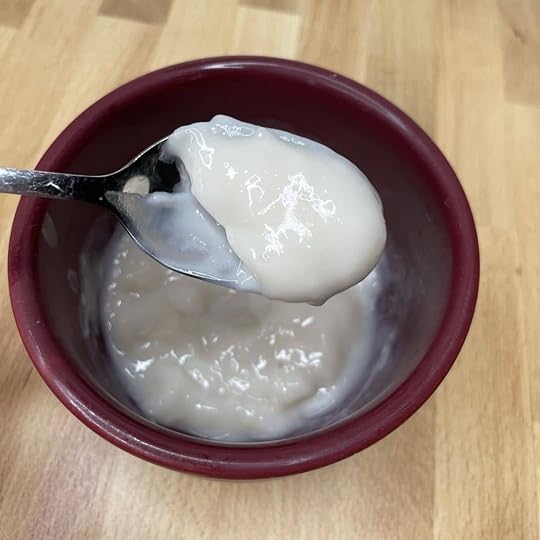 Why You'll Love this Dairy Free Pudding Recipe
Why You'll Love this Dairy Free Pudding RecipeThis kidney friendly pudding is popular all year round. It makes a low potassium, low sodium and low phosphorus dessert that everyone will love (and you don't have to tell them it is dairy free and they may never know).
This is just another one of my desserts, like the Strawberry Jello Pudding (or the Sugar Free Jello Pudding with Applesauce) that makes a yummy end to your meal. Try it today, and you will love being able to have dessert again.
[feast_advanced_jump_to]Ingredients in Non Dairy PuddingRegular dairy milk does contain more protein, phosphorus, potassium than almond milk, so I chose to make a just as delicious pudding using a nut milk that doesn't change the flavor for you to enjoy.
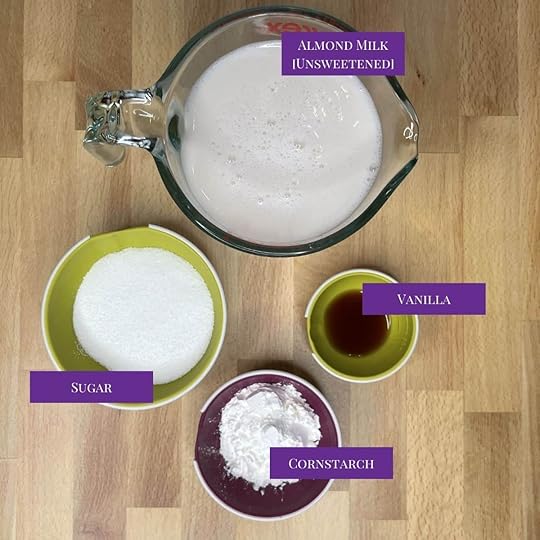 Unsweetened Almond Milk - easy to find at most grocery stores and makes a gluten free vanilla puddingSugar - makes the pudding just a little sweet and tastyCornstarch - thickens the pudding without adding any flavor for the gluten free dairy free pudding
Unsweetened Almond Milk - easy to find at most grocery stores and makes a gluten free vanilla puddingSugar - makes the pudding just a little sweet and tastyCornstarch - thickens the pudding without adding any flavor for the gluten free dairy free puddingSee recipe card for quantities.
How to Make Dairy Free Vanilla Pudding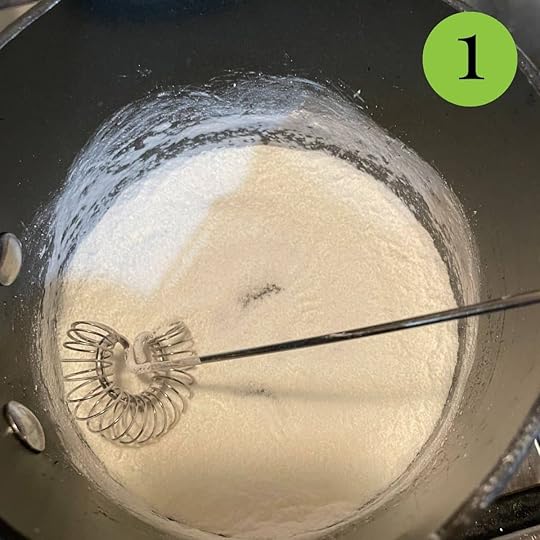
1. In a medium saucepan, whisk together the sugar and cornstarch.
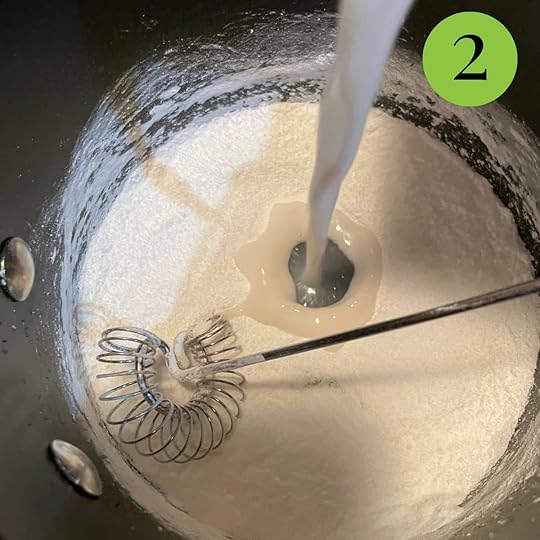
2. Slowly add the milk beverage while whisking, until smooth. Make sure everything is dissolved.
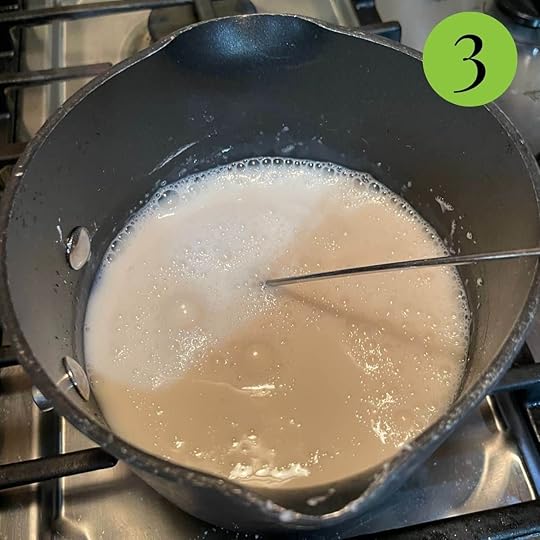
3. Place the pan over medium-low heat. If it begins to boil, turn the heat to low. Stir continuously.
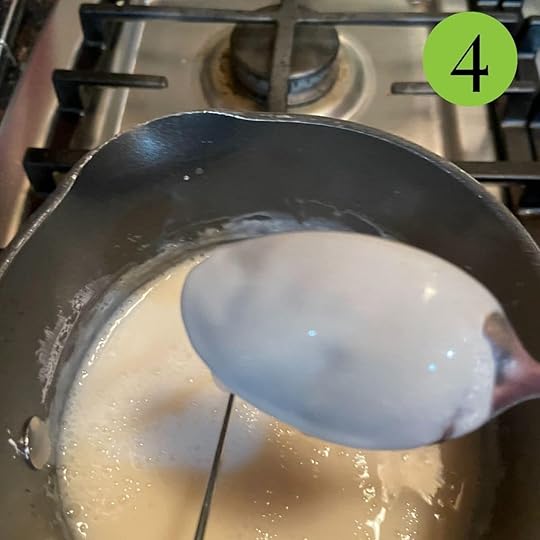
4. Cook while whisking until the mixture thickens enough to coat the back of a metal spoon, about 8-10 minutes.
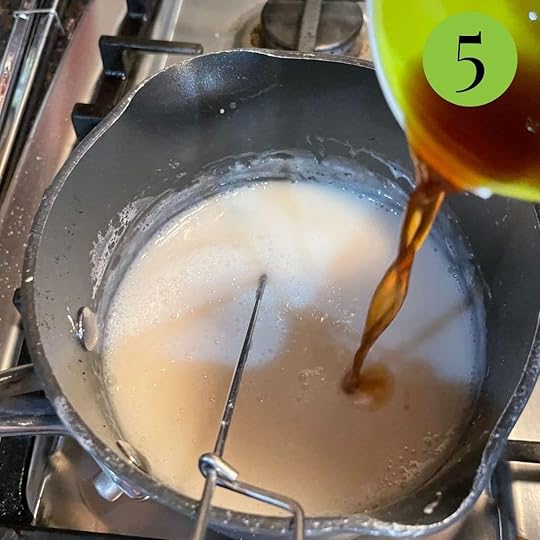
5. Remove the pan from heat and whisk in the vanilla.
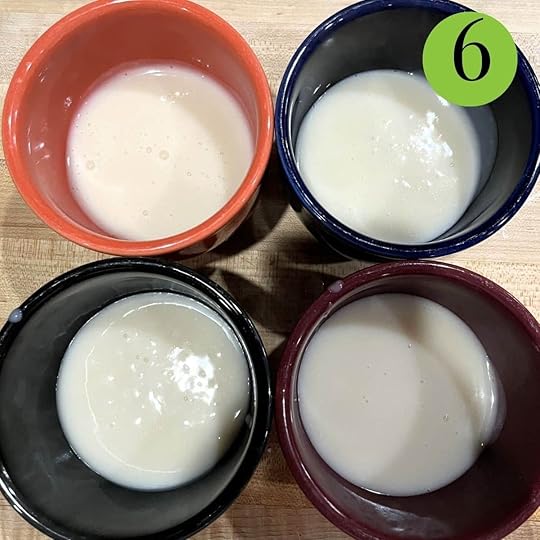
6. Pour the pudding into 4 individual serving dishes. Place the pudding in your refrigerator and chill for 2 hours or until set.
Hint: It might form a skin on top of the pudding but you can easily stir the pudding after 2 hours to get rid of the skin.
Substitutions in Dairy Free Pudding CupsSubstituting almond milk with other non-dairy milks can offer variety and cater to different dietary preferences or restrictions. Here's how some alternatives might work in this dairy-free dessert recipe:
Coconut Milk Pudding RecipeProfile: Coconut milk is richer and creamier than almond milk, with a distinct tropical flavor. It can add a luxurious texture to desserts.
Consideration: It's higher in calories and fat, which can be a factor for individuals managing their weight or cholesterol levels. For CKD patients, ensure it fits within your nutritional guidelines, especially regarding potassium content.Soy Milk Non Dairy Pudding
Profile: Soy milk has a creamy texture and a slightly nutty flavor. It's a good source of protein and can provide a more satisfying mouthfeel to desserts.
Consideration: Some individuals may have soy allergies or sensitivities. Additionally, soy milk's protein content is something to consider for CKD patients who may need to manage their protein intake.Dairy Free Rice Milk Pudding
Profile: Rice milk is the most hypoallergenic of all milk alternatives, with a naturally sweet flavor and a thinner consistency than almond milk.
Consideration: It's low in protein and higher in carbohydrates, which could impact blood sugar levels. Its thin consistency may require adjustments in thickening agents, meaning you may need to add more cornstarch.Oat Milk Dairy Free Pudding
Profile: Oat milk is creamy and has a mild, slightly sweet flavor, making it a popular choice for both savory and sweet dishes. It can add a smooth texture to desserts.
Consideration: It's higher in carbohydrates and calories, which may be a concern for individuals with diabetes or those monitoring calorie intake. Oat milk also contains a moderate amount of phosphorus, so CKD patients should consider this.Variations of Lactose Free Pudding
Creating variations of this dairy-free dessert recipe, specifically tailored for individuals with chronic kidney disease (CKD), involves considering dietary restrictions often recommended for CKD patients, such as limiting sodium, potassium, and phosphorus intake.
Here are several variations that keep these considerations in mind, while adding variety and appeal to the dessert:
Fruit Flavored Add-InsIngredients: Add pureed low-potassium fruits like apples, berries, or grapes to the mixture. Ensure the fruits are fresh or canned in water without added sugars or syrups.
Why: These fruits are generally lower in potassium, making them safer for people with CKD. They also add natural sweetness and flavor.Herbal or Spice Infusion
Ingredients: Infuse the milk with cinnamon, cardamom, or mint leaves during the heating process.
Why: Herbs and spices add complex flavors without contributing significant amounts of potassium, phosphorus, or sodium.Lemon or Lime Zest
Ingredients: Add a teaspoon of lemon or lime zest to the mixture for a citrusy twist.
Why: Citrus zest adds bright flavor without additional potassium, as you're using only the outer skin, not the fruit itself.Coffee or Cocoa
Ingredients: Add a teaspoon of instant coffee or a tablespoon of cocoa powder (ensure it's low in potassium and phosphorus).
Why: Both coffee and cocoa can add a rich, deep flavor. Be mindful of the quantities, as too much can increase potassium and phosphorus levels.Vanilla Bean Paste
Ingredients: Use vanilla bean paste instead of vanilla extract for a more intense vanilla flavor.
Why: Vanilla bean paste adds small specks of vanilla bean, enhancing the visual appeal and flavor of the dessert without affecting kidney health.Almond Extract or Other Flavor Extracts
Ingredients: Experiment with almond extract, orange extract, or other kidney-friendly flavor extracts to diversify flavors without adding harmful substances.
Why: These extracts can dramatically change the profile of your dessert with just a few drops, without introducing ingredients that might be restricted for CKD patients.
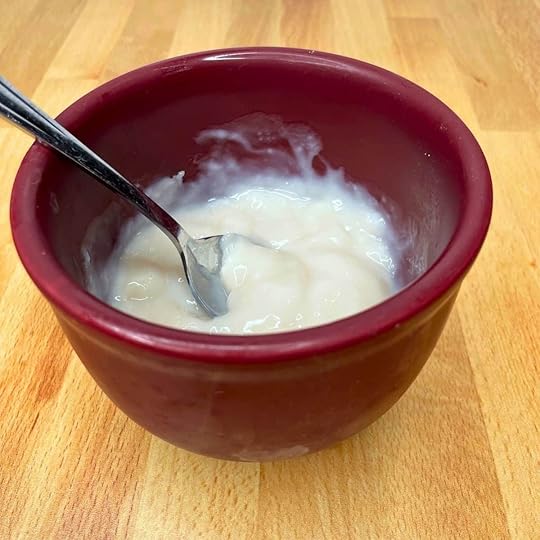 Storage For Jello Pudding Non Dairy Milk
Storage For Jello Pudding Non Dairy MilkYou can easily store this pudding covered in the refrigerator for up to 3 days after you make it. Just give it a stir before serving to make it yummy.
Top tipIf the pudding is too thin for your liking, you can add more cornstarch as it's cooking. Just add about 1 teaspoon at a time to a little bit of almond milk (or whatever non dairy milk you are using) and stir BEFORE you add it to the mixture. Don't add cornstarch directly to the mixture because it will clump.
FAQ about Dairy Free PuddingCan I make dairy-free pudding without using cornstarch? What are the alternatives?Yes, you can make dairy-free pudding without cornstarch by using several alternative thickeners. Arrowroot powder and tapioca starch are great options for a smooth texture, similar to cornstarch, and they work well in acidic recipes. Agar-agar, a vegan gelatin substitute made from seaweed, is another excellent choice for creating a firmer set pudding. When substituting, keep in mind that the thickening power of each alternative can vary, so you may need to adjust the quantities. Start with a direct substitution and adjust as needed for your desired consistency.
Is dairy-free pudding healthy?Dairy-free pudding can be a healthier option, especially for those who are lactose intolerant, allergic to dairy, or following a vegan diet. By using plant-based milks and controlling the amount of added sugars, you can create a dessert that's lower in saturated fats and cholesterol-free. However, the healthiness also depends on the other ingredients you use. Opting for natural sweeteners, limiting the use of processed ingredients, and incorporating nutritious toppings like fresh fruit can make your pudding a healthier treat. Remember, moderation is key, as even healthier versions of desserts can contribute to excessive calorie intake if consumed in large amounts.
How can I store dairy-free pudding, and how long will it last in the fridge?Dairy-free pudding should be stored in an airtight container in the refrigerator. To prevent a skin from forming on the top, you can place a piece of plastic wrap directly on the surface of the pudding before covering it with a lid. Properly stored, dairy-free pudding can last for up to 5 days in the fridge. It's not recommended to freeze dairy-free pudding, as the thawing process can affect its texture, making it grainy or separating the ingredients. Always check the pudding before consuming it if it has been stored for several days to ensure it's still fresh.
What To Do With Pudding That Won't Set?If you've made dairy-free pudding and it won't set, there are several strategies you can try to salvage it. The key is to understand why it didn't set in the first place, which could be due to insufficient thickening agent, undercooking, or incorrect ingredient ratios. Here are some solutions:
Re-cook with Additional ThickenerIf the pudding hasn't set, it might need more thickening agent. You can try adding a bit more cornstarch, arrowroot powder, or tapioca starch. First, mix the additional thickener with a small amount of cold liquid to make a slurry, then stir it into the pudding and cook it over medium heat until it thickens, stirring constantly to prevent lumps.
Use It as a Sauce or ToppingIf the pudding is slightly runny but you don't want to alter it further, consider using it as a sauce or topping for desserts. It can be poured over cakes, pancakes, waffles, or ice cream for added flavor.
Make a TrifleLayer your runny pudding with pieces of cake or cookies and fresh fruit to create a trifle. The cake or cookies will absorb some of the liquid, and you'll end up with a delicious, layered dessert.
Turn It into a Smoothie or ShakeBlend the runny pudding with fruits, ice, and perhaps a bit of additional milk to create a delicious smoothie or shake. This can be a creative and refreshing way to repurpose your pudding.
Freeze It into PopsiclesPour the runny pudding into popsicle molds and freeze. While it may not have set as a pudding, it can still make a tasty frozen treat, especially in warmer weather.
Thicken It with Chia SeedsFor a no-cook option, you can thicken your pudding by adding chia seeds. Mix in a few tablespoons of chia seeds and let the mixture sit in the refrigerator. The chia seeds will absorb the liquid and expand, thickening the pudding naturally. This also adds a nutritional boost.
Tips for Preventing Runny Pudding in the Future:Measure Ingredients Accurately: Incorrect proportions can lead to setting issues.Fully Dissolve the Thickener: Make sure the cornstarch (or alternative thickener) is fully dissolved in a cold liquid before adding it to the hot mixture to prevent clumps and ensure even thickening.Cook Long Enough: Cooking for too short a time can prevent the thickener from reaching its full potential. Make sure to bring the mixture to a brief boil and then simmer as directed, stirring constantly.By trying these solutions, you can find a way to use your dairy-free pudding, ensuring that your efforts and ingredients don't go to waste.
Related Kidney Friendly RecipesLooking for other recipes like this? Try these:
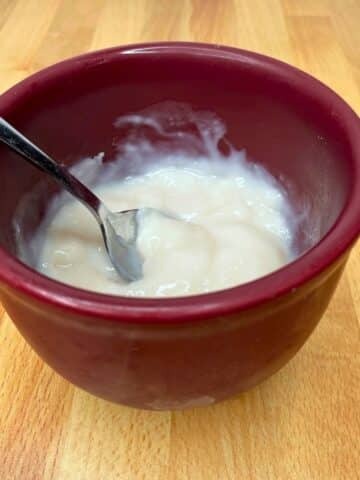 Dairy Free Pudding [Vegan And Kidney Friendly]
Dairy Free Pudding [Vegan And Kidney Friendly] Bacon Wrapped Turkey Breast Tenderloin Recipe Low Sodium
Bacon Wrapped Turkey Breast Tenderloin Recipe Low Sodium Low Sodium Arugula Frittata Recipe
Low Sodium Arugula Frittata Recipe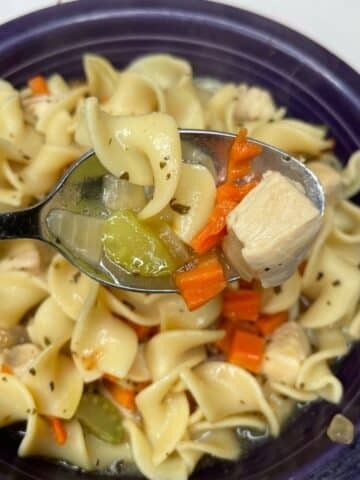 Low Sodium Chicken Noodle Soup Recipe
Low Sodium Chicken Noodle Soup RecipeIf you tried this Recipe or any other recipe on my website, please please leave a ð star rating and let me know how it goes in the ð comments below. I love hearing from you!
Printð Recipe.tasty-recipes-print-button{background-color:#667;border:none;display:inline-block;padding:.5em 1em;text-decoration:none}body:not(.tasty-recipes-print-view) .tasty-recipes-print-button.tasty-recipes-print-above-card{color:#fff;display:none}body:not(.tasty-recipes-print-view) .tasty-recipes-print-button.tasty-recipes-print-above-card:hover{background-color:#b2b2bb;color:#fff;display:inline-block;padding:.5em 1em;text-decoration:none}.tasty-recipes-image-button-container{display:flex;flex-direction:column;flex-wrap:wrap;float:right;margin-left:10px}body.tasty-recipes-print-view .tasty-recipes-buttons,body.tasty-recipes-print-view .tasty-recipes-cook-mode{display:none}.tasty-recipes-image-button-container .tasty-recipes-buttons{margin-bottom:10px;margin-top:10px}.tasty-recipes-image-button-container .tasty-recipes-button-wrap{box-sizing:border-box;margin-bottom:10px}.tasty-recipes-image-button-container .tasty-recipes-buttons a,.tasty-recipes-quick-links a.button{background-color:#f9f9f9;background-color:var(--tr-button-color,#f9f9f9);border:1px solid #aaa;border-color:var(--tr-button-color,#aaa);border-radius:0;color:#aaa;color:var(--tr-button-text-color,#aaa);cursor:pointer;display:block;font-size:16px;font-weight:700;line-height:16px;margin-top:0;padding:8px;text-align:center;text-decoration:none;text-transform:uppercase}.tasty-recipes-quick-links a.button{display:inline-block;margin-left:.625em;margin-right:.625em}.tasty-recipes-quick-links a.button span{display:none}.tasty-recipes-entry-content .tasty-recipes-buttons a:hover,.tasty-recipes-image-button-container .tasty-recipes-buttons .button:hover,.tasty-recipes-quick-links a.button:hover{background-color:var(--tr-button-text-color,#aaa);color:var(--tr-button-color,#f9f9f9);text-decoration:none}.tasty-recipes-image-button-container .tasty-recipes-buttons .button:hover{opacity:1}.tasty-recipes-image-button-container .tasty-recipes-buttons a:hover{background-color:#979599;text-decoration:none}.tasty-recipes-image-button-container .tasty-recipes-buttons svg{display:none}.tasty-recipes-yield-scale{border:1px solid #979599;border-radius:2px;color:#979599;font-size:.7rem;margin-left:3px;padding:0 4px}.tasty-recipes-units-scale-container{display:flex;flex-wrap:wrap}.tasty-recipes-convert-container{padding:0 1em 1em 0}.tasty-recipes-convert-container .tasty-recipes-convert-label{align-self:center;color:#979599;font-size:.6rem;text-transform:uppercase}.tasty-recipes-convert-container button{background:transparent;border:1px solid #353547;border-radius:2px;color:#353547;letter-spacing:0;margin-left:5px;min-width:34px;padding:2px 4px;text-align:center}.tasty-recipes-convert-container button.tasty-recipes-convert-button-active{background-color:#000;border-color:#000;color:#fff}.tasty-recipes-convert-container button:focus{outline:none}.tasty-recipes-scale-container{display:flex;padding:0 0 1em}.tasty-recipes-scale-container .tasty-recipes-scale-label{align-self:center;color:#979599;font-size:.6rem;text-transform:uppercase}.tasty-recipes-scale-container button{background:transparent;border:1px solid #353547;border-radius:2px;color:#353547;cursor:pointer;letter-spacing:0;margin-left:5px;min-width:34px;padding:2px 4px}.tasty-recipes-scale-container button.tasty-recipes-scale-button-active{background-color:#000;border-color:#000;color:#fff}.tasty-recipes-scale-container button:focus{outline:none}.tasty-recipes-ingredients-header{margin:1em 0}@media only screen and (min-width:520px){.tasty-recipes-ingredients-header{align-items:center;display:flex;flex-wrap:wrap;justify-content:space-between}}.tasty-recipes-ingredients-header .tasty-recipes-ingredients-clipboard-container{align-items:baseline;display:inline-flex}.tasty-recipes-ingredients-header h3{margin:0 10px 10px 0}.tasty-recipes-ingredients-clipboard-container .tasty-recipes-copy-button{background:transparent;border:none;color:#353547;height:24px;padding:0;position:relative;width:24px}.tasty-recipes-ingredients-clipboard-container .tasty-recipes-copy-button:hover{opacity:.5}.tasty-recipes-instructions-header{align-items:baseline;display:flex;flex-wrap:wrap;justify-content:space-between;margin:1em 0}.tasty-recipes-entry-content .tasty-recipes-instructions h3{margin:0 0 1rem}@media only screen and (min-width:520px){.tasty-recipes-entry-content .tasty-recipes-instructions h3{margin:0}}button[name=tasty-recipes-video-toggle]{background:#979599;border:#979599;border-radius:2px;display:inline-block;font-size:14px;height:30px;line-height:20px;margin:0;padding:0;text-align:center;vertical-align:middle;width:86px}button[name=tasty-recipes-video-toggle] span{padding:0 4px;pointer-events:none}button[name=tasty-recipes-video-toggle][aria-checked=false] :last-child,button[name=tasty-recipes-video-toggle][aria-checked=true] :first-child{background:#fff;border-radius:2px;color:#979599;padding:2px 4px}button[name=tasty-recipes-video-toggle][aria-checked=false] :first-child,button[name=tasty-recipes-video-toggle][aria-checked=true] :last-child{color:#fff}label[for=tasty-recipes-video-toggle]{color:#979599;font-size:.6rem;line-height:30px;padding-right:8px;text-transform:uppercase;user-select:none;-moz-user-select:none;-ms-user-select:none;-webkit-user-select:none;-o-user-select:none;vertical-align:middle}.tasty-recipe-responsive-iframe-container{margin:10px 0}.tasty-recipes-equipment{display:flex;flex-wrap:wrap;justify-content:space-evenly}.tasty-recipes-equipment>h3{flex:0 0 100%}.tasty-recipes-equipment .tasty-link-card{flex:0 0 50%;padding:1.5rem 1rem;text-align:center}@media screen and (min-width:500px){.tasty-recipes-equipment .tasty-link-card{flex:0 0 33%}}.tasty-recipes-equipment .tasty-link-card p{font-size:1em;font-weight:700;margin-bottom:0}.tasty-recipes-equipment .tasty-link-card p a{color:initial}.tasty-recipes-equipment .tasty-link-card span{font-size:.9em}.tasty-recipes .tasty-recipes-nutrition ul{list-style-type:none;margin:0;padding:0}.tasty-recipes .tasty-recipes-nutrition ul:after{clear:both;content:" ";display:block}.tasty-recipes .tasty-recipes-nutrition li{float:left;list-style-type:none;margin-bottom:0;margin-left:0;margin-right:16px}.tasty-recipes-plug{align-items:center;display:flex;flex-wrap:wrap;justify-content:center;margin-bottom:1em;text-align:center}.tasty-recipes-plug a{box-shadow:none;text-decoration:none}.tasty-recipes-plug a img{background:transparent;box-shadow:none;display:inline-block;height:auto;margin:5px 0 0 8px;padding:0;width:150px}.tasty-recipes-footer-content{padding:1.5em;text-align:center}.tasty-recipes-footer-content .tasty-recipes-footer-copy{margin-left:0}.tasty-recipes-footer-content img,.tasty-recipes-footer-content svg{width:60px}.tasty-recipes-entry-content .tasty-recipes-entry-footer h3{font-size:1.25em;margin:0 0 .25em;padding:0}.tasty-recipes-entry-footer p{font-size:.75em;margin:0}.tasty-recipes-entry-footer p a{border-bottom:none;box-shadow:none;text-decoration:underline}.tasty-recipes-flash-message{background-color:#fff;border-radius:4px;box-shadow:0 .3px .4px 0 rgba(0,0,0,.024),0 .9px 1.5px 0 rgba(0,0,0,.05),0 3.5px 6px 0 rgba(0,0,0,.1);color:#313135;display:inline-block;font-size:13px;letter-spacing:0;line-height:1.2em;margin-left:10px;padding:4px 10px}@media screen and (min-width:500px){.tasty-recipes-flash-message{padding:4px 10px}}.tasty-recipes-flash-message p{margin:0;padding:0;text-transform:none}@media screen and (min-width:500px){.tasty-recipes-footer-content{align-items:center;display:flex;justify-content:center;padding:1.5em 0;text-align:left}.tasty-recipes-footer-content .tasty-recipes-footer-copy{margin-left:.8em}}@media print{.tasty-recipes-no-print,.tasty-recipes-no-print *{display:none!important}}[data-tr-ingredient-checkbox]{cursor:pointer;list-style-position:outside;list-style-type:none!important;margin-left:0!important}[data-tr-ingredient-checkbox] .tr-ingredient-checkbox-container{position:relative}[data-tr-ingredient-checkbox] .tr-ingredient-checkbox-container input[type=checkbox] label{display:inline-block;position:relative;vertical-align:middle}[data-tr-ingredient-checkbox] .tr-ingredient-checkbox-container input[type=checkbox]{clip:rect(1px 1px 1px 1px);clip:rect(1px,1px,1px,1px);height:1px;overflow:hidden;position:absolute!important;width:1px}[data-tr-ingredient-checkbox] .tr-ingredient-checkbox-container input[type=checkbox] label:before{border:1px solid;border-radius:2px;content:"";display:inline-block;height:20px;margin-right:10px;position:relative;width:20px}[data-tr-ingredient-checkbox] .tr-ingredient-checkbox-container input[type=checkbox]:checked label:after{border-bottom:2px solid;border-left:2px solid;content:"";display:inline-block;height:6px;left:4px;position:absolute;top:4px;transform:rotate(-45deg);width:12px}[data-tr-ingredient-checkbox] .tr-ingredient-checkbox-container input[type=checkbox]:focus label:before{box-shadow:0 0 8px #5e9ed6;outline:1px solid #5d9dd5}[data-tr-ingredient-checkbox=checked]{opacity:.8;text-decoration:line-through}.tasty-recipes-cook-mode__container{align-items:center;display:flex;line-height:100%}.tasty-recipes-cook-mode__container label{font-size:inherit}.tasty-recipes-cook-mode__switch{display:inline-block;height:17px;margin-right:10px;position:relative;width:30px}.tasty-recipes-cook-mode__switch-slider{background-color:#737373;bottom:0;cursor:pointer;display:block;left:0;opacity:.4;position:absolute;right:0;top:0;transition:.4s}.tasty-recipes-cook-mode__switch-slider:before{background-color:#fff;bottom:2px;content:"";height:13px;left:2px;position:absolute;transition:.4s;width:13px}.tasty-recipes-cook-mode__switch input{display:none}.tasty-recipes-cook-mode__switch input:checked span{opacity:1}.tasty-recipes-cook-mode__switch input:checked span:before{transform:translateX(13px)}.tasty-recipes-cook-mode__switch-round{border-radius:34px}.tasty-recipes-cook-mode__switch-round:before{border-radius:50%}.tasty-recipes-cook-mode__label{font-weight:700}@media only screen and (max-width:767px){#shop-with-instacart-v1{transform:scale(.75);transform-origin:top left}}body{ --tr-star-color:#000000;--tr-button-color:#0B4115;--tr-button-text-color:#FFFFFF; }.tasty-recipes-rating-solid.tasty-recipes-clip-10{-webkit-clip-path:polygon(0 0,10% 0,10% 100%,0 100%);clip-path:polygon(0 0,10% 0,10% 100%,0 100%)}.tasty-recipes-rating-solid.tasty-recipes-clip-20{-webkit-clip-path:polygon(0 0,20% 0,20% 100%,0 100%);clip-path:polygon(0 0,20% 0,20% 100%,0 100%)}.tasty-recipes-rating-solid.tasty-recipes-clip-30{-webkit-clip-path:polygon(0 0,30% 0,30% 100%,0 100%);clip-path:polygon(0 0,30% 0,30% 100%,0 100%)}.tasty-recipes-rating-solid.tasty-recipes-clip-40{-webkit-clip-path:polygon(0 0,40% 0,40% 100%,0 100%);clip-path:polygon(0 0,40% 0,40% 100%,0 100%)}.tasty-recipes-rating-solid.tasty-recipes-clip-50{-webkit-clip-path:polygon(0 0,50% 0,50% 100%,0 100%);clip-path:polygon(0 0,50% 0,50% 100%,0 100%)}.tasty-recipes-rating-solid.tasty-recipes-clip-60{-webkit-clip-path:polygon(0 0,60% 0,60% 100%,0 100%);clip-path:polygon(0 0,60% 0,60% 100%,0 100%)}.tasty-recipes-rating-solid.tasty-recipes-clip-70{-webkit-clip-path:polygon(0 0,70% 0,70% 100%,0 100%);clip-path:polygon(0 0,70% 0,70% 100%,0 100%)}.tasty-recipes-rating-solid.tasty-recipes-clip-80{-webkit-clip-path:polygon(0 0,80% 0,80% 100%,0 100%);clip-path:polygon(0 0,80% 0,80% 100%,0 100%)}.tasty-recipes-rating-solid.tasty-recipes-clip-90{-webkit-clip-path:polygon(0 0,90% 0,90% 100%,0 100%);clip-path:polygon(0 0,90% 0,90% 100%,0 100%)}.tasty-recipes-rating-outline{display:inline-block;height:1em;line-height:1;width:1em}.tasty-recipes-rating-outline.tasty-recipes-clip-0 svg{fill:url(#tasty-recipes-clip-0)}.tasty-recipes-rating-outline.tasty-recipes-clip-10 svg{fill:url(#tasty-recipes-clip-10)}.tasty-recipes-rating-outline.tasty-recipes-clip-20 svg{fill:url(#tasty-recipes-clip-20)}.tasty-recipes-rating-outline.tasty-recipes-clip-30 svg{fill:url(#tasty-recipes-clip-30)}.tasty-recipes-rating-outline.tasty-recipes-clip-40 svg{fill:url(#tasty-recipes-clip-40)}.tasty-recipes-rating-outline.tasty-recipes-clip-50 svg{fill:url(#tasty-recipes-clip-50)}.tasty-recipes-rating-outline.tasty-recipes-clip-60 svg{fill:url(#tasty-recipes-clip-60)}.tasty-recipes-rating-outline.tasty-recipes-clip-70 svg{fill:url(#tasty-recipes-clip-70)}.tasty-recipes-rating-outline.tasty-recipes-clip-80 svg{fill:url(#tasty-recipes-clip-80)}.tasty-recipes-rating-outline.tasty-recipes-clip-90 svg{fill:url(#tasty-recipes-clip-90)}.tasty-recipes-rating-outline.tasty-recipes-clip-100 svg{fill:url(#tasty-recipes-clip-100)}.comment-content .tasty-recipes-rating-outline.tasty-recipes-clip-100 svg{fill:currentColor}.tasty-recipes,.tasty-recipes-ratings{--tr-star-size:18px;--tr-star-margin:0px}.tasty-recipes-rating,.tasty-recipes-ratings-buttons{color:#f2b955;color:var(--tr-star-color,#f2b955)}.tasty-recipes-comment-form{border:none;margin:0;padding:0}.tasty-recipes-entry-header div.tasty-recipes-rating p,.tasty-recipes-rating-stars,.tasty-recipes-ratings,.tasty-recipes-ratings-buttons{display:inline-flex;font-size:1.1em;font-size:var(--tr-star-size);gap:.3em;gap:var(--tr-star-margin)}.tasty-recipes-entry-header div.tasty-recipes-rating p span.tasty-recipes-rating,.tasty-recipes-rating-stars span.tasty-recipes-rating,.tasty-recipes-ratings span.tasty-recipes-rating,.tasty-recipes-ratings-buttons span.tasty-recipes-rating{cursor:pointer;display:inline-block;font-size:1.1em;font-size:var(--tr-star-size);margin:0;width:1.1em;width:var(--tr-star-size)}.tasty-recipes-entry-header div.tasty-recipes-rating p{display:flex;justify-content:center}.tasty-recipes-ratings-buttons{flex-direction:row-reverse}.tasty-recipes-ratings-buttons input[type=radio]{clip:auto;display:inline-block!important;width:1.1em!important;width:var(--tr-star-size)!important}.tasty-recipes-ratings-buttons>span{position:relative}.tasty-recipes-ratings-buttons>span i{font-style:normal}.tasty-recipes-ratings-buttons>span .unchecked{display:inline-block}.tasty-recipes-ratings-buttons>input:checked~span .unchecked,.tasty-recipes-ratings-buttons>span .checked{display:none}.tasty-recipes-ratings-buttons>input:checked~span .checked{display:inline-block}@media only screen and (min-width:1024px){.tasty-recipes-ratings-buttons:not(:hover)>input:checked~span .unchecked,.tasty-recipes-ratings-buttons>:hover .unchecked,.tasty-recipes-ratings-buttons>:hover~span .unchecked{display:none}.tasty-recipes-ratings-buttons:not(:hover)>input:checked~span .checked,.tasty-recipes-ratings-buttons>:hover .checked,.tasty-recipes-ratings-buttons>:hover~span .checked{display:inline-block}}.tasty-recipes-ratings-buttons>input{cursor:pointer;height:100%;margin:0;margin-left:calc((var(--tr-star-size) var(--tr-star-margin))*-1);opacity:0;position:relative;z-index:2}.tasty-recipes-rating a,.tasty-recipes-rating a:link{background:none;outline:none;text-decoration:none}.tasty-recipes-screen-reader{clip:rect(1px,1px,1px,1px);word-wrap:normal!important;border:0;-webkit-clip-path:inset(50%);clip-path:inset(50%);height:1px;margin:-1px;overflow:hidden;padding:0;position:absolute;width:1px}.tasty-recipes-rating-link{align-items:center;display:inline-flex}.tasty-recipes-rating-link .rating-label{font-size:80%;padding-left:.4em}.tasty-recipes-selected-minimum-rating .comment-form-comment .required{display:none}.tasty-recipes-has-ratings{text-decoration:none!important}Dairy Free Pudding [Vegan And Kidney Friendly]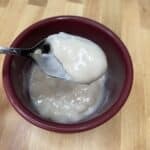 [image error] Print Recipe [image error] Pin Recipe const share_pin_buttons = document.getElementsByClassName( 'share-pin button' ); if ( share_pin_buttons ) { for ( let share_key = 0; share_key < share_pin_buttons.length; share_key ) { share_pin_buttons[share_key].addEventListener( 'click', (e) => { e.stopPropagation(); window.open(e.target.dataset.href,'targetWindow','toolbar=no,location=no,status=no,menubar=no,scrollbars=yes,resizable=yes,width=500,height=500'); return false; } ); } }
[image error] Print Recipe [image error] Pin Recipe const share_pin_buttons = document.getElementsByClassName( 'share-pin button' ); if ( share_pin_buttons ) { for ( let share_key = 0; share_key < share_pin_buttons.length; share_key ) { share_pin_buttons[share_key].addEventListener( 'click', (e) => { e.stopPropagation(); window.open(e.target.dataset.href,'targetWindow','toolbar=no,location=no,status=no,menubar=no,scrollbars=yes,resizable=yes,width=500,height=500'); return false; } ); } } ★★★★★
5 from 1 review
Yummy! Make this easy 4 ingredient recipe and eat over the next couple of days.
Author: Mathea Ford, MBA, RDN, LD Prep Time: 5 minutes Refrigerate: 2 hours Cook Time: 10 minutes Total Time: 2 hours 15 minutes Yield: 4 Category: Dessert Method: Stove Top Cuisine: American Diet: Low Salt Ingredientsâ cup granulated sugar
3 tablespoons cornstarch
2 cups unsweetened almond milk
1 tsp vanilla extract
Cook Mode Prevent your screen from going dark Instructions1. In a medium saucepan, whisk together the sugar and cornstarch. Â
2. Slowly add the milk beverage while whisking, until smooth. Make sure everything is dissolved.
3. Place the pan over medium-low heat.  If it begins to boil, turn the heat to low. Stir continuously.
4. Cook while whisking until the mixture thickens enough to coat the back of a metal spoon. about 8-10 minutes.
5. Remove the pan from heat and whisk in the vanilla. Â
6. Pour the pudding into 4 individual serving dishes.Â
7. Place the pudding in your refrigerator and chill for 2 hours or until set. It might form a skin on top of the pudding but you can easily stir the pudding after 2 hours to get rid of the skin.Â
8 Cover and store leftovers in the refrigerator for up to 3 days. Â
NotesMake ahead for any night of the week. Make sure you cook it until it thickens.
(function(){ window.addEventListener( 'message', function( event ){ if ( ( 'https://nutrifox.com' !== event.origin && 'https://nutrifox.test' !== event.origin ) || typeof event.data !== 'string' ) { return; } var payload = JSON.parse( event.data ); switch ( payload.event ) { case 'setHeight': var iframe = document.getElementById( 'nutrifox-label-' payload.recipeId ); iframe.style.height = payload.height 'px'; break; } } );}());Keywords: dairy free pudding, non dairy pudding, jello pudding non dairy milk, dairy free vanilla pudding, gluten free vanilla pudding, dairy free pudding recipe
Did you make this recipe?Share a photo and tag us â we can't wait to see what you've made!
window.tasty_recipes_min_rating = 4;(function(){document.querySelectorAll('[data-tr-ingredient-checkbox]').forEach(function(el) {var input = el.querySelector('.tr-ingredient-checkbox-container input[type="checkbox"]');if ( ! input ) {return;}if (input.checked) {el.dataset['trIngredientCheckbox'] = 'checked';}el.addEventListener('click', function(event) {if ( 'A' === event.target.nodeName|| 'INPUT' === event.target.nodeName|| 'LABEL' === event.target.nodeName ) {return;}input.click();});input.addEventListener('change', function() {el.dataset['trIngredientCheckbox'] = input.checked ? 'checked' : '';});});}());window.TastyRecipes = window.TastyRecipes || {};window.TastyRecipes.cookMode = {wakeLockApi: false,wakeLock: false,cookModeSelector: '.tasty-recipes-cook-mode',init() {if ("wakeLock" in navigator && "request" in navigator.wakeLock) {this.wakeLockApi = navigator.wakeLock;}const cookModes = document.querySelectorAll(this.cookModeSelector);if (cookModes.length > 0) {for (const cookMode of cookModes) {if (this.wakeLockApi) {cookMode.querySelector('input[type="checkbox"]').addEventListener("change", event => {this.checkboxChange(event.target);}, false);} else {cookMode.style.display = "none";}}}},checkboxChange(checkbox) {checkbox.checked ? this.lock() : this.unlock();},setCheckboxesState(state) {const checkboxes = document.querySelectorAll(this.cookModeSelector ' input[type="checkbox"]');for (const checkbox of checkboxes) {checkbox.checked = state;}},async lock() {try {this.wakeLock = await this.wakeLockApi.request("screen");this.wakeLock.addEventListener("release", event => {this.wakeLock = false;this.setCheckboxesState(false);});this.setCheckboxesState(true);} catch (error) {this.setCheckboxesState(false);}},unlock() {if (this.wakeLock) {this.wakeLock.release();this.wakeLock = false;}this.setCheckboxesState(false);}};(function(callback) {if (document.readyState !== "loading") {callback();} else {document.addEventListener("DOMContentLoaded", callback);}})(() => {window.TastyRecipes.cookMode.init();});window.TastyRecipes = window.TastyRecipes || {};window.TastyRecipes.ratings = {init( min_rating ) {this.min_rating = min_rating;this.recipeRatingReflectInRespondSection();this.addBodyClassBasedOnSelectedRating();this.backwardCompRespondRatingPosition();},recipeRatingReflectInRespondSection() {const ratings = document.querySelectorAll('.tasty-recipes-no-ratings-buttons [data-rating]');if (ratings.length <= 0) {return;}for (const rating of ratings) {rating.addEventListener( 'click', event => {this.fireRatingInRespond( event.target.dataset.rating );} );}},fireRatingInRespond( rating ) {const ratingInput = document.querySelector('.tasty-recipes-rating[value="' rating '"]');if ( ! ratingInput ) {return;}ratingInput.click();},addBodyClassBasedOnSelectedRating() {const ratingInputs = document.querySelectorAll('input.tasty-recipes-rating');if ( ratingInputs.length <= 0 ) {return;}for ( const ratingInput of ratingInputs ) {ratingInput.addEventListener( 'click', event => {let selectedRating = event.target.getAttribute( 'value' );this.handleBodyClassByRating( selectedRating );this._toggle_comment_textarea_required( selectedRating );} );}},handleBodyClassByRating( rating ) {if ( rating < this.min_rating ) {document.body.classList.remove( 'tasty-recipes-selected-minimum-rating' );return;}document.body.classList.add( 'tasty-recipes-selected-minimum-rating' );},_toggle_comment_textarea_required( rating ) {const comment_textarea = document.getElementById( 'comment' );if ( 0 >= comment_textarea.length ) {return;}if ( rating < this.min_rating ) {comment_textarea.setAttribute( 'required', '' );return;}comment_textarea.removeAttribute('required');},backwardCompRespondRatingPosition() {const ratings_buttons = document.querySelector( '#respond .tasty-recipes-ratings-buttons' );if ( !ratings_buttons || ratings_buttons.length <= 0 ) {return;}const ratings_buttons_styles = window.getComputedStyle(ratings_buttons);if ( 'flex' !== ratings_buttons_styles.display ) {ratings_buttons.style.direction = 'rtl';}const rating_spans = ratings_buttons.querySelectorAll( '.tasty-recipes-rating' );for (const rating_span of rating_spans) {rating_span.addEventListener( 'click', event => {if ( rating_span === event.target ) {return;}rating_span.previousElementSibling.click();} );}}};(function(callback) {if (document.readyState !== "loading") {callback();} else {document.addEventListener("DOMContentLoaded", callback);}})(() => {window.TastyRecipes.ratings.init( window.tasty_recipes_min_rating );});Recipe Card powered by [image error]The post Dairy Free Pudding [Vegan And Kidney Friendly] appeared first on Renal Diet HQ.
Suggested Reading:
Chronic Kidney Disease Laboratory TestsSugar Free Jello With Applesauce RecipeLow Sodium Low Potassium Recipes for the HolidaysJanuary 12, 2024
Chronic Kidney Disease: Diet Portion Control Essentials- Podcast

Living with Chronic Kidney Disease (CKD) presents unique challenges, but with the right approach to diet and portion control, managing the condition becomes more manageable. In this guide, we'll delve into the importance of nutrition, portion control strategies, and practical tips tailored specifically for CKD patients.
Meet Mathea Ford, a registered dietitian specializing in CKD and owner of Renal Diet HQ. With her expertise, we'll explore how simple dietary changes can lead to significant improvements in overall health and well-being for individuals living with CKD.
Understanding Chronic Kidney Disease (CKD)For More Recipes and Ideas --->> Get Your Free Meals and Recipes That Are Perfect for Pre-Dialysis Diets, Pre-Dialysis with Diabetes, or Dialysis Diets.
Chronic Kidney Disease, or CKD, is a prevalent condition affecting millions in the US. Management strategies often revolve around lifestyle modifications, including dietary adjustments. By understanding the role of diet and portion control, individuals with CKD can better manage their symptoms and improve their quality of life.
The Role of Portion Control in CKD ManagementPortion control is a vital component of CKD management, offering numerous benefits such as symptom reduction and minimizing complications associated with the condition. By learning how to control portion sizes effectively, CKD patients can take control of their health and well-being.
Nutritional Needs for CKD PatientsBalancing nutritional needs is crucial for CKD patients. Carbohydrates, proteins, fats, and minerals like sodium, potassium, and phosphorus must be monitored closely. Understanding calorie intake and hydration needs also plays a significant role in managing CKD effectively.
Practical Tips for Portion ControlImplementing portion control strategies can seem daunting, but with practical tips tailored to CKD patients, it becomes more manageable. From grocery shopping to mindful eating practices, CKD patients can make healthier choices and maintain proper portion sizes both at home and while dining out.
Implementing Portion Control in Daily LifeIncorporating portion control into daily life requires commitment and consistency. Using smaller plates, measuring utensils, and tracking food intake are effective strategies. By making small changes and practicing mindful eating, CKD patients can enjoy delicious meals while maintaining healthy portions.
Collaboration with Healthcare ProfessionalsCollaboration with healthcare professionals, particularly dietitians, is essential for CKD management. Working together to create personalized meal plans and seeking support from healthcare providers can lead to better outcomes for individuals living with CKD.
Managing CKD through diet and portion control is achievable with the right knowledge and support. By implementing practical tips and working closely with healthcare professionals, CKD patients can take charge of their health and improve their overall well-being. For further guidance and support, visit Renal Diet HQ and take the first step towards a healthier lifestyle today.
The post Chronic Kidney Disease: Diet Portion Control Essentials- Podcast appeared first on Renal Diet HQ.
Suggested Reading:
What Is Chronic Kidney DiseaseDiet Vs Medication for CKD ImprovementImprove My Stage of CKDJanuary 10, 2024
Myth VS Fact CKD Treatment Is Always The Same- Podcast
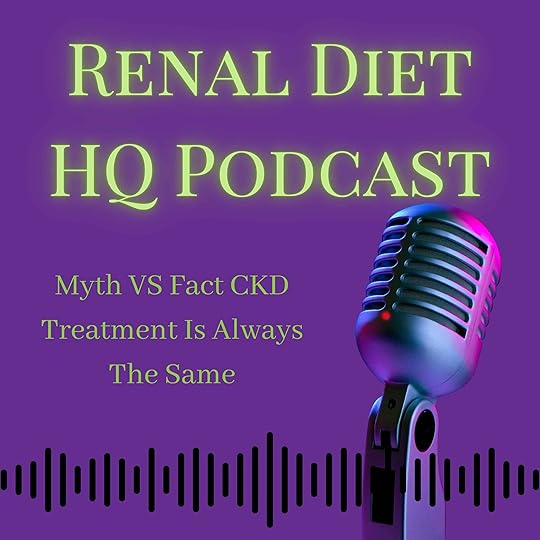
Chronic kidney disease (CKD) affects millions of individuals worldwide, yet there persists a common misconception surrounding its treatmentâthat it follows a one-size-fits-all approach. In this article, we aim to debunk this myth and shed light on the diverse and personalized nature of CKD treatment. Understanding the complexity of CKD and the importance of tailored treatment plans is crucial for effective management of this condition.
Understanding CKD: A Complex DiseaseFor More Recipes and Ideas --->> Get Your Free Meals and Recipes That Are Perfect for Pre-Dialysis Diets, Pre-Dialysis with Diabetes, or Dialysis Diets.
CKD is characterized by a progressive loss of kidney function, impacting various aspects of an individual's health. It's essential to recognize that CKD is not a uniform condition; rather, it manifests differently in each person. This complexity underscores the fallacy of assuming a standardized treatment approach for all CKD patients.
Debunking the Myth of Uniform TreatmentThe notion that CKD treatment is uniform for all individuals is a pervasive myth that can significantly impact how people perceive and manage the condition. By dispelling this myth, we empower individuals to seek personalized care that aligns with their specific needs and circumstances.
Individualized Treatment PlansThe cornerstone of CKD management lies in the development of individualized treatment plans. These plans are tailored to factors such as the stage of the disease, underlying causes, coexisting health conditions, and lifestyle factors. Recognizing and addressing these unique aspects of each patient's condition is essential for optimizing treatment outcomes.
Examples of Diverse Treatment ApproachesTo illustrate the diversity of CKD treatment approaches, let's consider two hypothetical scenarios. In one scenario, an individual in the early stages of CKD with diabetes as the underlying cause may require a different treatment plan compared to someone in later stages whose CKD is attributed to hypertension. These examples highlight the need for personalized care tailored to the specific circumstances of each patient.
Range of Treatment OptionsCKD treatment encompasses a wide range of options, including lifestyle modifications, medications for blood pressure, cholesterol, anemia, and bone health, as well as advanced interventions. The availability of these diverse treatment modalities underscores the importance of collaboration between patients and healthcare providers to determine the most suitable approach for managing CKD.
Collaborative Care ApproachEffective CKD management necessitates a collaborative care approach involving various healthcare professionals, including primary doctors, nephrologists, dietitians, and other specialists. By working together, healthcare teams can develop comprehensive and personalized treatment plans that address the unique needs of each patient.
The myth of uniform CKD treatment is debunked, emphasizing the importance of personalized care tailored to individual circumstances. By understanding the diverse nature of CKD and advocating for collaborative care approaches, individuals can take proactive steps towards effectively managing this condition and improving their overall quality of life.
We invite readers to share their experiences or questions regarding CKD treatment in the comments section below. Additionally, for those seeking further information or support, we provide links to reputable resources and support networks dedicated to CKD management. Together, let's foster a community of knowledge and support to empower individuals on their journey towards optimal kidney health.
The post Myth VS Fact CKD Treatment Is Always The Same- Podcast appeared first on Renal Diet HQ.
Suggested Reading:
What Is Chronic Kidney DiseaseImprove My Stage of CKDDiet Vs Medication for CKD ImprovementJanuary 5, 2024
The Truth About Chocolate in a Renal Diet - Safe or Risky? Renal Dietitian Tells All- Podcast

Are you or a loved one grappling with chronic kidney disease (CKD) and wondering if indulging in chocolate is a safe treat? While chocolate can be rich in nutrients, it's crucial for individuals with CKD to understand the potential risks and benefits before satisfying their sweet tooth. In this guide, we'll delve into the world of chocolate consumption for CKD patients, exploring the types of chocolate that are best suited for their dietary needs and offering tips for making informed choices. Let's navigate through the complexities of chocolate consumption and discover how CKD patients can enjoy sweet treats while prioritizing their health.
Understanding Chocolate and CKDFor More Recipes and Ideas --->> Get Your Free Meals and Recipes That Are Perfect for Pre-Dialysis Diets, Pre-Dialysis with Diabetes, or Dialysis Diets.
Individuals living with CKD must exercise caution when it comes to consuming chocolate due to its high mineral content, particularly potassium and phosphorus. These minerals, in excess, can pose risks for kidney function, especially in advanced stages of the disease. However, chocolate, especially dark chocolate with a high cocoa content, also boasts potential health benefits for CKD patients, such as cardiovascular protection and reduction of inflammation. Understanding the delicate balance between the risks and benefits of chocolate consumption is essential for CKD patients to make informed dietary choices.
Types of Chocolate Suitable for CKD PatientsWhen it comes to selecting chocolate, CKD patients should opt for varieties that are lower in potassium and phosphorus. Dark chocolate with at least 70% cocoa content is often a safer option, as it contains fewer additives and higher levels of beneficial antioxidants. These antioxidants can help combat oxidative stress and inflammation, contributing to better overall health for CKD patients. By choosing carefully and prioritizing quality over quantity, CKD patients can enjoy the occasional indulgence in chocolate while mitigating potential risks.
Risks Associated with Chocolate Consumption for CKD PatientsDespite its potential health benefits, chocolate consumption for CKD patients requires careful consideration due to its mineral content. Excessive intake of potassium and phosphorus, common in many chocolate products, can exacerbate kidney dysfunction, particularly in individuals with advanced CKD or those undergoing dialysis. It's crucial for CKD patients to be mindful of portion sizes and to consult with healthcare professionals, including renal dietitians, to ensure that their chocolate consumption aligns with their specific dietary restrictions and health needs.
Guidelines for Safe Chocolate ConsumptionTo safely incorporate chocolate into a CKD diet, patients should adhere to certain guidelines. These include reading nutrition labels to identify chocolate products with lower potassium and phosphorus content, controlling portion sizes to avoid overconsumption of minerals, and considering sugar-free alternatives to manage blood sugar levels. Moderation is key, and CKD patients should work closely with healthcare professionals to tailor their chocolate consumption to their individual dietary requirements and health goals.
Alternatives and RecommendationsIn addition to chocolate, CKD patients can explore a variety of other sweet treats that are lower in potassium and phosphorus. Options such as jelly beans, mints, marshmallows, and licorice without added salt can provide satisfying alternatives to chocolate while still satisfying cravings for sweetness. By diversifying their dessert options and being mindful of nutritional content, CKD patients can indulge in occasional treats without compromising their kidney health.
Chocolate can be a delicious indulgence for CKD patients when consumed responsibly and in moderation. By understanding the risks and benefits associated with chocolate consumption, as well as adhering to dietary guidelines and consulting with healthcare professionals, CKD patients can enjoy sweet treats while prioritizing their overall health and well-being. With informed choices and personalized guidance, CKD patients can navigate the world of chocolate with confidence, savoring every bite while safeguarding their kidney health for the future.
The post The Truth About Chocolate in a Renal Diet - Safe or Risky? Renal Dietitian Tells All- Podcast appeared first on Renal Diet HQ.
Suggested Reading:
What Is Chronic Kidney DiseaseCKD Diet GuidelinesImprove My Stage of CKDDecember 29, 2023
Are Berries High In Potassium? Berries and Beyond Choosing LowPotassium Foods for Kidney Health- Podcast

Living with chronic kidney disease (CKD) brings unique challenges, particularly in balancing potassium levels within the body. Potassium, an essential mineral vital for functions such as blood pressure regulation and muscle control, requires meticulous attention for individuals with CKD. In this thorough guide, we delve into the importance of potassium management, effective strategies for maintaining optimal levels, and practical advice for integrating low-potassium alternatives into your diet.
Understanding Potassium and its Role in the BodyFor More Recipes and Ideas --->> Get Your Free Meals and Recipes That Are Perfect for Pre-Dialysis Diets, Pre-Dialysis with Diabetes, or Dialysis Diets.
Potassium is indispensable for overall health, regulating blood pressure, facilitating muscle function, and supporting nerve transmission. However, CKD patients face hurdles due to compromised kidney function, hindering the elimination of excess potassium and potentially leading to health complications.
The Impact of Potassium on CKD ManagementElevated potassium levels, termed hyperkalemia, pose serious risks for CKD patients, including cardiac irregularities and muscle weakness. Thus, diligent monitoring of potassium intake is paramount, particularly as CKD progresses.
Potassium-Rich Foods and Their EffectsFoods naturally abundant in potassium, such as fruits, vegetables, and dairy products, can contribute to heightened potassium levels in CKD patients. While these foods offer nutritional benefits, their consumption may necessitate limitations or careful oversight to avert adverse effects.
Strategies for Potassium ManagementEffectively managing potassium intake involves implementing dietary constraints and practicing portion moderation. Collaborating with a specialized registered dietitian can aid in crafting a personalized meal plan tailored to individual requirements, ensuring optimal potassium levels and overall kidney health.
Low-Potassium Alternatives and OptionsThankfully, numerous low-potassium alternatives cater to the needs of CKD patients. Berries, including blueberries, cranberries, and raspberries, provide delectable choices with reduced potassium content. Integrating these fruits into the diet can deliver essential nutrients while minimizing potassium intake.
Serving Size ConsiderationsVigilantly monitoring serving sizes is imperative for controlling potassium intake effectively. For instance, scaling back portion sizes of potassium-rich foods like potatoes and tomatoes can aid in managing daily potassium levels. Seeking guidance from healthcare professionals for personalized advice on appropriate serving sizes is advisable.
Monitoring Potassium Levels and Seeking Medical GuidanceRegular monitoring of potassium levels through blood tests is essential for evaluating the efficacy of dietary approaches. CKD patients should collaborate closely with healthcare providers, including dietitians, to ensure optimal potassium management and overall kidney health.
Managing potassium levels amid chronic kidney disease necessitates meticulous attention to dietary selections, portion control, and medical oversight. By comprehending the role of potassium in bodily functions and employing effective management strategies, individuals with CKD can foster kidney health and enhance overall well-being. Remember, proactive management and close collaboration with healthcare experts are pivotal in sustaining optimal potassium levels and enhancing quality of life.
The post Are Berries High In Potassium? Berries and Beyond Choosing LowPotassium Foods for Kidney Health- Podcast appeared first on Renal Diet HQ.
Suggested Reading:
What Is Chronic Kidney DiseaseCKD Diet GuidelinesDiabetic Renal Diet Meal PlanDecember 27, 2023
Myth VS Fact CKD Is Not Related To Mental Health- Podcast
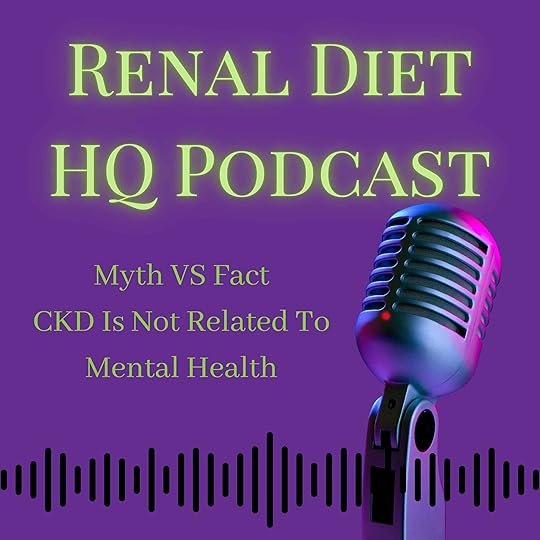
Hello, everyone, and welcome to today's discussion. We're diving into a topic that often takes a back seat in conversations about chronic kidney disease (CKD) â mental health. Contrary to a prevailing myth, CKD isn't solely a physical challenge; it extends its reach into the realm of emotional well-being. Let's unravel this misconception and shed light on the crucial intersection of CKD and mental health.
CKD and Mental Health: Debunking the MythFor More Recipes and Ideas --->> Get Your Free Meals and Recipes That Are Perfect for Pre-Dialysis Diets, Pre-Dialysis with Diabetes, or Dialysis Diets.
Is it accurate to say that CKD doesn't affect mental health? In reality, the impact on emotional well-being is profound. Dealing with CKD introduces a spectrum of emotions â from the anxieties of living with a chronic illness to the stress of managing the condition and, at times, even feelings of frustration and depression. It's crucial to acknowledge these emotional responses as normal reactions to the challenges posed by CKD.
The Emotional Landscape of CKDConsider this â CKD necessitates significant lifestyle changes, constant management, and regular doctor's appointments. The stress accompanying these aspects can introduce uncertainty about one's health. These factors collectively take a toll on mental and emotional health, emphasizing the need to address this often-overlooked aspect of CKD.
Importance of Mental Health Care in CKD ManagementEmotional support becomes an integral part of managing CKD. Whether it's from friends, family, support groups, or mental health professionals â all forms of support are appropriate and valuable. Recognizing that mental health is as important as physical health in the healing process, it fosters a deep connection within oneself. Managing stress, seeking support, and being open about your emotions can significantly impact your CKD journey.
Practical Strategies for Managing Mental Health in CKDTo navigate the emotional landscape of CKD, practical strategies come into play. Managing stress becomes pivotal, and seeking support from various channels â be it friends, family, or mental health professionals â becomes a cornerstone. Open communication about emotions further aids in creating a positive impact on the CKD journey through effective mental health care.
Breaking Down the Myth: CKD Does Affect Mental HealthLet's debunk the myth once and for all â CKD does affect mental health. Addressing this reality is the key to overall well-being. We invite you to share your experiences and thoughts on this topic in the comments below because sharing can be healing, and we're all in this together, helping one another navigate the challenges of CKD.
It's essential to acknowledge the mental health aspect of CKD. By recognizing its impact and seeking support, we can enhance our overall well-being in the face of this challenging condition. Remember, you're not alone in this journey. Wishing you all a great day, and thank you for being part of this important conversation.
The post Myth VS Fact CKD Is Not Related To Mental Health- Podcast appeared first on Renal Diet HQ.
Suggested Reading:
What Is Chronic Kidney DiseaseImprove My Stage of CKDWhy Do You Need A Pre-Dialysis Diet PlanDecember 22, 2023
Anemia and Chronic Kidney Disease CKD Symptoms Risk Factors Complications and Treatments- Podcast

Chronic kidney disease (CKD) is a complex health condition, and it's crucial to be aware of potential complications that may arise. Among these complications, anemia is prevalent, impacting over one in seven individuals with CKD. In this blog post, we will delve into the intricacies of anemia, exploring its causes, symptoms, diagnosis, treatment options, complications, and ongoing research. Let's embark on this journey to comprehend and manage anemia effectively.
Anemia in Chronic Kidney DiseaseFor More Recipes and Ideas --->> Get Your Free Meals and Recipes That Are Perfect for Pre-Dialysis Diets, Pre-Dialysis with Diabetes, or Dialysis Diets.
Anemia, characterized by a deficiency of healthy red blood cells, is a common occurrence in CKD. Its symptoms, including fatigue, weakness, and shortness of breath, can significantly affect the quality of life for those living with CKD.
Importance of Early DetectionEarly detection and correction of anemia play a pivotal role in improving outcomes for CKD patients. Recognizing symptoms and intervening promptly can slow the progression of kidney disease and enhance overall well-being.
Causes and Mechanisms of Anemia in CKDUnderstanding the causes of anemia in CKD involves exploring the impaired kidney function affecting erythropoietin (EPO) production, disruption of iron balance, and the accumulation of uremic toxins in the bloodstream. Inflammation associated with CKD further exacerbates anemia.
Risk Factors for Anemia in CKDRisk factors, including CKD stage, comorbidities like diabetes and hypertension, medications, gender, and nutritional deficiencies, contribute to the likelihood of developing anemia in individuals with CKD.
Diagnosis of Anemia in CKDAccurate diagnosis of anemia involves recognizing symptoms like tiredness, weakness, and shortness of breath. Laboratory testing is essential to differentiate anemia from other medical conditions with similar symptoms.
Treatment OptionsManaging anemia in CKD encompasses various treatment options, from iron supplementation to erythropoiesis-stimulating agents (ESA's) and, in severe cases, blood transfusions. Regular monitoring of hemoglobin levels is crucial for effective management.
Impact of Anemia on Overall HealthAnemia not only worsens cardiovascular disease but also negatively affects kidney disease progression, immune system function, cognitive abilities, and overall well-being. Recognizing and addressing anemia is essential for holistic health management.
Dietary Approaches to Manage AnemiaBalanced meal planning, addressing nutrient deficiencies through diet, adhering to dietary restrictions, and considering supplements under healthcare guidance are crucial aspects of managing anemia through nutrition.
Ongoing Research and Future PerspectivesCurrent research explores areas such as the gut microbiome's role in anemia and potential novel treatments like stem cell therapy and gene therapy. Understanding patient perspectives aids in developing effective prevention strategies and treatments.
Anemia is a common and impactful complication in CKD. This blog post aimed to provide comprehensive insights into its various facets, from causes to treatment options. Individualized care and collaboration with healthcare professionals are key to effectively managing anemia, improving outcomes, and enhancing the overall quality of life for individuals with CKD. Stay informed and take proactive steps on your journey towards better health.
The post Anemia and Chronic Kidney Disease CKD Symptoms Risk Factors Complications and Treatments- Podcast appeared first on Renal Diet HQ.
Suggested Reading:
What Is Chronic Kidney DiseaseImprove My Stage of CKDHow Kidney Disease Is DiagnosedDecember 20, 2023
Myth VS Fact CKD Means Dialysis is Inevitable- Podcast
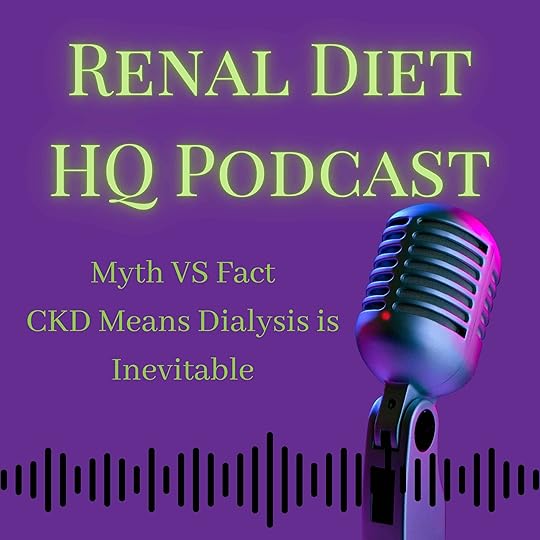
Greetings, everyone! Today, let's dive into a prevalent misconception surrounding Chronic Kidney Disease (CKD) â the belief that a CKD diagnosis inevitably leads to dialysis. Is this really true?
Understanding CKD:For More Recipes and Ideas --->> Get Your Free Meals and Recipes That Are Perfect for Pre-Dialysis Diets, Pre-Dialysis with Diabetes, or Dialysis Diets.
Definition of Chronic Kidney Disease (CKD)
CKD is a condition characterized by a gradual loss of kidney function over time. It's essential to grasp the nature of CKD before exploring the myth associated with it.
The Myth Unveiled:Addressing the Misconception
Many people assume that if diagnosed with CKD, dialysis is an unavoidable reality. However, let's go beyond this myth and uncover the broader story.
Effective Management of CKD:Lifestyle Changes
One of the keys to managing CKD effectively involves making lifestyle changes. Consulting with a dietitian can be a game-changer, where even simple adjustments, like reducing sodium intake and carefully managing protein consumption, play a crucial role. Moreover, incorporating regular exercise, even as simple as walking, can make a significant difference.
Medications and Their Role:Managing Symptoms and Slowing Progression
It's not just about symptom control. Medications play a pivotal role in managing CKD by slowing down its progression. Keeping factors like blood pressure and blood sugar under control is vital. While it may seem challenging, numerous individuals successfully manage CKD through these measures.
Success Stories in CKD Management:Inspiration from Real Experiences
Despite the challenges, many individuals lead fulfilling lives without reaching the stage of dialysis. Success stories abound, highlighting that effective management is indeed possible.
Individualized Journey with CKD:Emphasize Uniqueness
Each person's journey with CKD is unique. Collaborating closely with healthcare teams to create personalized plans is key to successful management.
A diagnosis of CKD doesn't automatically mean dialysis is inevitable. By embracing effective management strategies, individuals can lead fulfilling lives without reaching that stage. Let's dispel the myth and spread awareness about the possibilities.
The post Myth VS Fact CKD Means Dialysis is Inevitable- Podcast appeared first on Renal Diet HQ.
Suggested Reading:
What Is Chronic Kidney DiseaseImprove My Stage of CKDChronic Illness and CKDDecember 15, 2023
Nut Flour Magic Transform Your Kidney Diet with These Healthy Alternatives Kidney Dietitian- Podcast

Welcome to a culinary journey that not only tantalizes your taste buds but also caters to your kidney health needs. In this exploration, we delve into the realm of nut flowers, a versatile alternative to traditional wheat flour.
Nut Flowers and Their Benefits for CKD PatientsFor More Recipes and Ideas --->> Get Your Free Meals and Recipes That Are Perfect for Pre-Dialysis Diets, Pre-Dialysis with Diabetes, or Dialysis Diets.
Nut flowers emerge as culinary superheroes for individuals grappling with CKD. Boasting high protein content and rich flavor, these flowers bring both nutrition and taste to the forefront of your meals. With a touch of creativity and knowledge, integrating nut flowers into your diet can transform your eating experience, making it not just kidney-friendly but also enjoyable.
Nutritional Analysis: Choosing the Right Nut FlowerUnderstanding the nuances of nut flowers becomes crucial for CKD patients. While these flowers serve as an excellent substitute for all-purpose flour, their perishable nature demands careful consideration. We'll guide you through the nutritional landscape, shedding light on varying potassium and phosphorus levels in different nut flowers. For a deeper dive, check out our detailed nutritional information in the provided blog post link.
Types of Nut Flowers and Their Unique Health BenefitsLet's embark on a flavorful journey through almond flour, pecan flour, hazelnut flour, chestnut flour, and coconut flour. Discover the specific health benefits each brings to the tableâranging from protein richness to fiber content and even low glycemic index. Learn how to seamlessly incorporate these nut flowers into your favorite recipes, whether sweet or savory.
Cooking and Baking Tips with Nut FlowersMastering the art of cooking and baking with nut flowers requires finesse. Uncover the nuances in texture and structure, realizing that nut flower-based treats might be denser but offer a delicate tenderness. Adjusting recipes and baking techniques is key to achieving the perfect results. Let's ensure your transition from traditional wheat flour to nut flowers is smooth and delectable.
Storage and Preservation TechniquesPreserving the freshness of your nut flowers is paramount. Dive into the art of storage with airtight containers, labeling with dates, and keeping them away from strong odors. These simple techniques can extend the shelf life of your nut flowers, ensuring every culinary creation bursts with flavor.
Substitution Options and Recipe ModificationWorried about the lack of gluten in nut flowers? Fear not! Explore various substitution options like eggs, flaxseeds, chia seeds, and more. Taste testing becomes your ally as you gradually adjust recipes to achieve the desired texture. Discover the secrets to creating guilt-free, kidney-friendly treats with nut flowers.
As we conclude our exploration, let's recap the nutritional wonders that nut flowers bring to those navigating CKD. The journey to a healthier lifestyle starts with simple yet profound changes to your meals. With the guidance of healthcare professionals and the wealth of resources available at RenalDietHQ.Com, you're poised to embark on this culinary adventure with confidence.
Next StepsTake the first step towards a healthier you. Visit RenalDietHQ.Com today for additional resources and information tailored to CKD. Your culinary adventure with nut flowers awaits, promising not just nutrition but also a delightful symphony of flavors. Let's make every bite count on this journey to better kidney health.
The post Nut Flour Magic Transform Your Kidney Diet with These Healthy Alternatives Kidney Dietitian- Podcast appeared first on Renal Diet HQ.
Suggested Reading:
What Is Chronic Kidney DiseaseAre Kidney Beans Good for Kidneys?Protein for CKD Patients: Stage By StageDecember 8, 2023
The Renal Dietitians Secrets to Safe Eating for Kidney Health- Podcast

For those grappling with kidney disease, ensuring food safety becomes a crucial aspect of their daily lives. Beyond adhering to prescribed renal diet plans, individuals must also be vigilant about proper food handling to mitigate the risk of foodborne diseases. In this blog post, we'll delve into practical tips and guidelines to help individuals with kidney disorders safeguard their meals and enjoy a healthier lifestyle.
About the AuthorFor More Recipes and Ideas --->> Get Your Free Meals and Recipes That Are Perfect for Pre-Dialysis Diets, Pre-Dialysis with Diabetes, or Dialysis Diets.
Meet Mathea Ford, a registered dietitian nutritionist specializing in chronic kidney disease and the owner of Renal Diet HQ. With a passion for assisting individuals in improving their health through simple yet delicious dietary changes, Matthia is dedicated to transforming eating habits, boosting overall well-being, and ensuring every bite is a joy. Join her on this incredible journey to better health together.
Understanding the Risks for Kidney PatientsPeople living with kidney failure face elevated risks for infections due to compromised immune systems, high blood pressure, and potential electrolyte imbalances. Contaminants such as bacteria, viruses, parasites, and toxins can be present in food, making it crucial for individuals with kidney disease to be vigilant about food safety.
Food Safety Practices for Individuals with Kidney DiseaseTo prevent foodborne illnesses, safe food storage practices, including proper refrigeration and freezing, are paramount. This section emphasizes the significance of good hygiene, such as thorough handwashing and using separate utensils, to reduce the risk of contamination. Cooking food to safe temperatures is highlighted as a critical step in ensuring food safety.
Eating Out with Kidney DiseaseWhen dining out, individuals with kidney disease should inform servers of allergies or dietary restrictions to prevent allergic reactions. Tips for safe eating out, such as using separate utensils and cutting boards, are provided. The importance of considering cooking at home for better control over meals is also emphasized.
Meal Prepping and Storage for Kidney HealthProper food storage and handling during meal prepping, especially for those on a renal diet, are discussed. Tips include the use of dissolvable labels for tracking storage details and adhering to safety guidelines for leftovers. The effectiveness of canning and jarring pantry staples for extended shelf life is mentioned.
Food Preparation and Cooking for Kidney-Friendly DietsThis section emphasizes the importance of cooking foods thoroughly and safely for kidney-friendly diets. It discusses healthy alternatives, focusing on low sodium and low potassium options, and encourages the use of labels and nutritional information when eating out or ordering takeout.
Cleaning and Sanitizing SurfacesThe importance of using safe cleaning products and reading labels carefully is stressed. Various methods for cleaning kitchen tools and equipment are discussed, emphasizing the need for sanitizing surfaces to prevent contamination.
Proper Storage and Handling of Refrigerated and Frozen FoodsEnsuring food is stored at safe temperatures to preserve quality and nutrients is crucial. Proper refrigeration and freezing techniques, including labeling and checking for freezer burn, are explained. Safe defrosting techniques to maintain food safety are highlighted.
Choosing Safe and Suitable Foods for a Renal DietThe significance of checking labels for renal diet suitability, considering expiration dates, and careful food purchasing is discussed. Tips for budgeting, including buying in bulk and taking advantage of sales, are provided.
Ensuring Food Safety During ReheatingThis section stresses the importance of reheating foods at safe temperatures to avoid bacterial contamination. The use of food thermometers and proper reheating techniques for leftovers are discussed, emphasizing careful monitoring during the reheating process.
Ensuring food safety for individuals with kidney disease involves adopting simple habits for a healthier lifestyle. By following the outlined guidelines and incorporating them into daily routines, individuals can protect themselves from foodborne illnesses and enjoy a safe and delicious renal diet. Subscribe to Renal Diet HQ for more insightful content on navigating the challenges of kidney disease and embracing a healthier life.
The post The Renal Dietitians Secrets to Safe Eating for Kidney Health- Podcast appeared first on Renal Diet HQ.
Suggested Reading:
Diabetic Renal Diet Meal PlanWhat Is Chronic Kidney DiseaseProcessed Foods To Avoid With Chronic Kidney Disease


